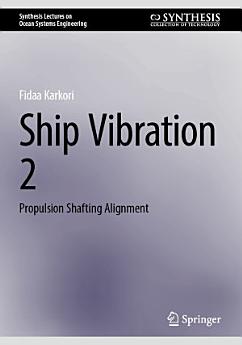Ship Vibration 2: Propulsion Shafting Alignment
Aug 2024 · Springer Nature
Ebook
110
Pages
reportRatings and reviews aren’t verified Learn More
About this ebook
Working and living onboard vessels imposes a series of generally low-frequency mechanical vibrations as well as single-impulse shock loads on the human body. Also, exposure to noise is characteristic aboard vessels. Low-frequency vibrations are created by vessel motions, which are produced by the various sea states in conjunction with vessel speed and point of sail. These motions can result in motion sickness, body instability, interruptions of task performance, sleep interruption and fatigue, increased health risk aggravated by shock loads due to slam and reduced human efficiency. Higher-frequency vibration influences comfort and is often associated with rotating machinery. The imposition of higher frequency vibrations (about 1 to 80 Hz) induces corresponding motions and forces within the human body creating discomfort and reduced human efficiency. With regard to noise, the above can similarly affect exposed humans, notably with sleep interruption and resulting fatigue, discomfort, and reduced efficiency. Also of concern are transient and permanent hearing loss, masking of audible signals, and interruption of speech communication. The concerns related to levels and characteristics of noise and vibration are covered in these two books which are related to habitability on ships and offshore structures. The purpose of this Book 2 is to provide clarification for Class Surveyors and plan review engineers to verify consistency of the survey and plan approval processes. Regarding the shaft alignment design and implementation efforts by the shipbuilding industry, this book is designed to further advance the technical approach towards shaft alignment analyses and procedures. The book is arranged to include topics on shaft alignment condition monitoring and a section dedicated to alignment problems and their solutions. Shaft alignment survey requirements are summarised in the introduction and are addressed further under a separate chapter on shaft alignment procedures and practices. Discussion on alignment calculation and measurement is expanded on to include the stern tube bearing clearance measurement. Additional clarification is provided on the application of the hull deflections, alignment optimisation, propulsion systems with no forward stern tube bearing, and reverse engineering calculations.
About the author
Fidaa Karkori is Senior Learning Development Consultant for a UK based marine training conusltancy, with a focus on training development, design and delivery. Fidaa has worked previously in the education and aviation sector before settling down in the training and professional development field.
Rate this ebook
Tell us what you think.
Reading information
Smartphones and tablets
Install the Google Play Books app for Android and iPad/iPhone. It syncs automatically with your account and allows you to read online or offline wherever you are.
Laptops and computers
You can listen to audiobooks purchased on Google Play using your computer's web browser.
eReaders and other devices
To read on e-ink devices like Kobo eReaders, you'll need to download a file and transfer it to your device. Follow the detailed Help Center instructions to transfer the files to supported eReaders.






